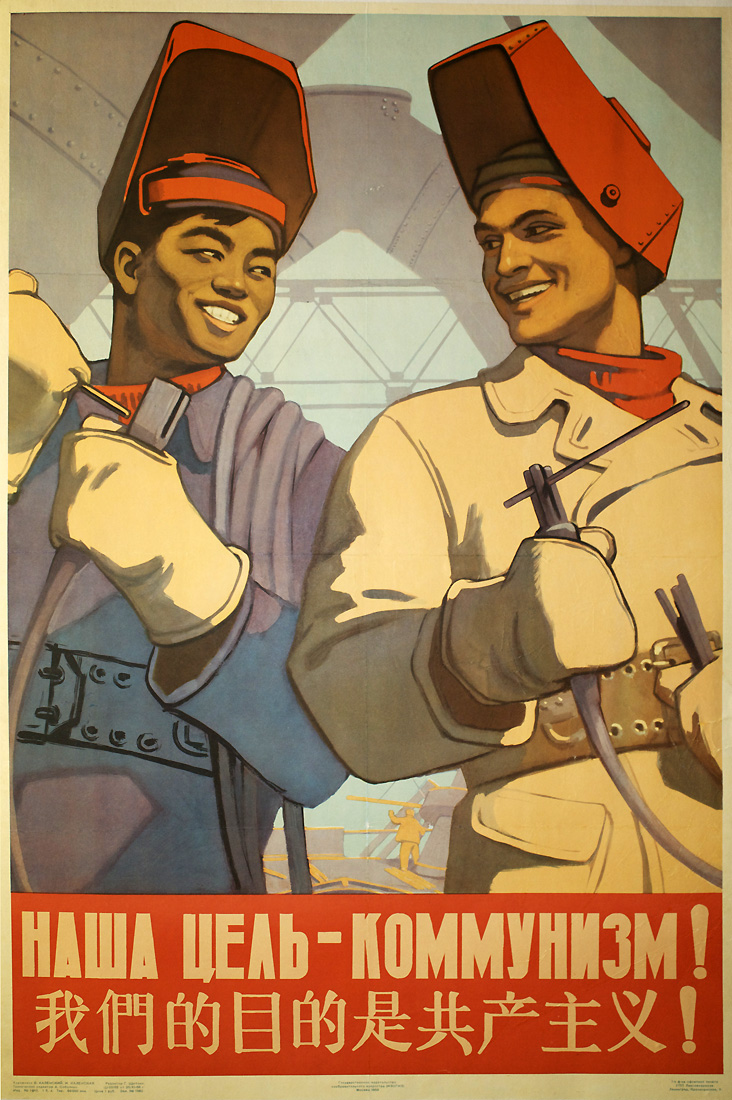
Our goal is Communism!
Poster Number: PP 300
Category: Workers
Poster Notes: Poster was produced during a time of political friendship between the USSR and Communist China. While their relations were frequently tenuous, the friendship broke down during the 1960s.
Media Size: 36x24
Poster Type: Offset
Publishing Date: 1959
Editorial Information: Editor G. Shchetkin; Technical Editor A. Soboleva.
Technical Information on Poster: [Approved] November 25, 1958; Publication No. 1-910; Volume 1 sheet of paper; Order No. 1982; Price 1 ruble.
Print Run: 60,000
Glavlit Directory Number: Sh-08192
Catalog Notes: PP 300 Workers
Language: Russian
Additional Languages: Chinese
Artist: Kalenskii, Vladimir Dionisievich — Каленский, Владимир Дионисиевич
Vladimir Dionisievich Kalenskii was known as a muralist and as a poster artist in the Soviet Union and in international art circles. In 1925, when his father was invited to work at the VSNKh (Supreme Economic Council of the USSR), the family moved to Moscow. In 1940, Kalenskii was called into active naval service and during World War II, he served with a submarine unit of the Northern Fleet. From 1945 to 1950, he attended the Moscow Higher School ...
Read More About This Artist
Artist: Kalenskaia, Irina Viktorovna — Каленская, Ирина Викторовна
Irina Viktorovna Kalenskaia was a Soviet graphic artist, an artist of monumental and decorative art, and she designed a myriad of political and social posters. Born in Moscow, Kalenskaia studied at the Moscow Regional Art Pedagogical School from 1944 to 1945. She then went on to the Moscow Higher School of Industrial Art where she graduated in 1954. Her thesis project was a sketch of a frieze for the Central Moscow Hippodrome, the largest horse racing track in ...
Read More About This Artist
Printer: 1st Offset Printing Plant of UPP of the Lensovnarkhoz, Leningrad — 1-я Ленсовнархоз УПП Типография Офсетной, Ленинград
The 1st Offset Printing Plant of the Lensovnarkhoz (Leningrad Economic Regional Council) was located near Kronverkskaia and Mir Streets in Leningrad (St. Petersburg). In the late 1950s until the early 1960s, the printer’s operations were managed by the UPP (Printing Industry Management) of Lensovnarkhoz but throughout its existence, the name of this printing plant changed depending on the various state-owned trusts that handled its management. Historically, the printer had roots in Imperial Russia as a ...
Read More About This Printer
Publisher: IzoGiz (State Publishing House of Fine Art), Moscow — Изогиз (Государственное издательство изобразительного искусства), Москва
The history of IzoGiz begins with the formation of Ogiz, the Association of the State Book and Magazine Publishers. In 1930, the Sovnarkom of the Russian Socialist Federative Soviet Republic established Ogiz to centralize publishing under a monopoly in order to eliminate duplication of printed material, to streamline and control publishing production and its output, and to create a base for marketing books, training and technical manuals. In 1931, the Central Committee of the USSR ordered certain ...
Read More About This Publisher